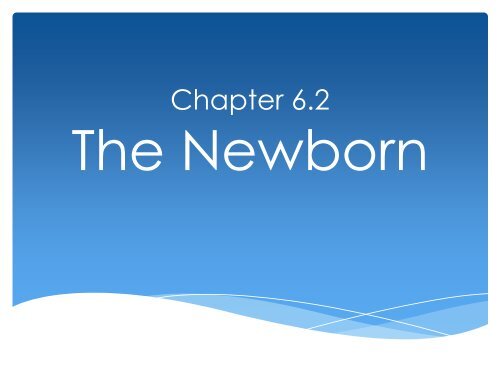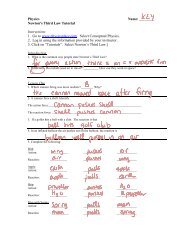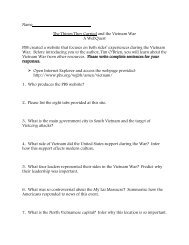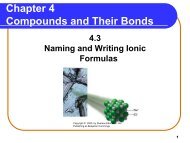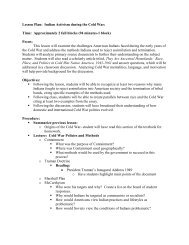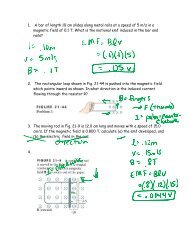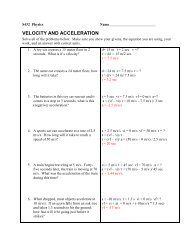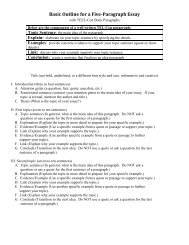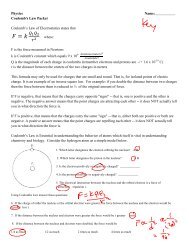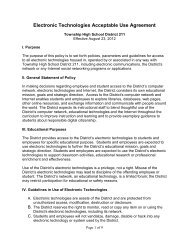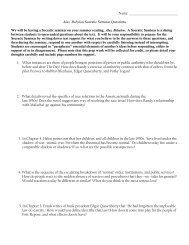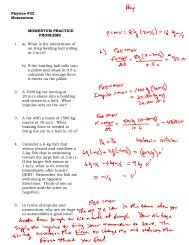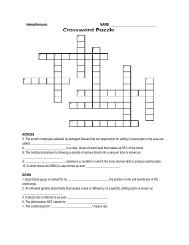You also want an ePaper? Increase the reach of your titles
YUMPU automatically turns print PDFs into web optimized ePapers that Google loves.
<strong>Chapter</strong> <strong>6.2</strong><strong>The</strong> <strong>Newborn</strong>
<strong>Newborn</strong> Tests Apgar Scale: System of rating the physical condition of thenewborn.1. Heart Rate2. Breathing3. Muscle Tone4. Response to Stimulation5. Skin Color Blood Test:-Umbilical Cord: Blood Type-Heel: Diseases and disorders
Apgar ScoreActivityPulseGrimaceAppearanceRespirationChecked one minute after birth, thenagain 5 minutes after birth
<strong>Newborn</strong>’s Appearance Head is too big for body Skull pointed or lopsided Fingers and toes may be coolerfor the first 24 hours Fontanel: Open space found on the baby’s head wherethe bones are not yet joined. (Soft spots)
Lanugo
Milia
Vernix
Umbilical Cord Stump
<strong>Chapter</strong> 6.3Postnatal Period
Neonatal Period <strong>The</strong> first month after the baby is born A healthy mother and baby can go homewithin 12 hours of birth, average stay 1-2 days Jaundice: Causes baby’s skin to look yellowOccurs in more than 50% of newbornsUntreated-Can cause damage to the Nervous System
Jaundice
Jaundice Phototherapy
Bonding with the <strong>Newborn</strong> Bonding is forming and emotional tie between theparent and child Bonding helps the baby build connections in thebrain Immediately after birth Nurse may place baby onmothers stomach-Baby can feel warmth of mothers skin-Also can hear the mothers voice and heartbeat
Breast FeedingAppearance Short, flat noses Receding chins Chubby cheeks Colostrum: High calorie, high-protein early breast milk.Protects baby from illnesses.<strong>The</strong> small features of the baby’s face make it easier tonurse, and latch onto the mothers breasts.
Feeding All babies loose weight during the first few days oflife, but regain it back later Babies may be too tired to eatroom-Wake them by exposing them to air in the-A light massage to stimulate
Lactation Consultant Lactation Consultant: Professional breastfeeding specialist who shows mother how toencourage milk production and how to position thebaby
Reflexes Instinctive, automatic response Rooting: search for food Sucking: suck on whatever is in mouth Grasping: grip on whatever is in palm Walking: take “steps” Startle (Moro): arms fling out & in Babinski: toes curl Reflexes Video
Well-Baby Check-Up Periodic check-ups to monitor healthy growth& development Recommended Months 1, 2, 4, 6, 9 & 12
Postnatal Period <strong>The</strong> time following a baby’s birth-Responsible for well-being of newborn-Mothers who had C-Section have a longerrecovery time <strong>The</strong> mother also has many physical needs duringthe Postnatal Period
Physical Needs Rest: Sleep when baby does Help from relatives Exercise: With doctors approval walking/stretching etc Nutrition: Follow MyPyramidPlan 300 calories more if breast feeding Lots of fluids Checkups: 4-6 weeks after birth Checks on involution (uterus returns to normal size)
Emotional Needs “Baby Blues”: Very common, mother may cry for noreason, feel irritable, lonely, anxious, or sad. Postpartum Depression: Condition where newmothers may feel very sad, cry a lot, little energy, havelittle interest in the baby.-Extreme Cases, may think about harmingthe baby.-Treatment is available, medication, talking to atherapist


